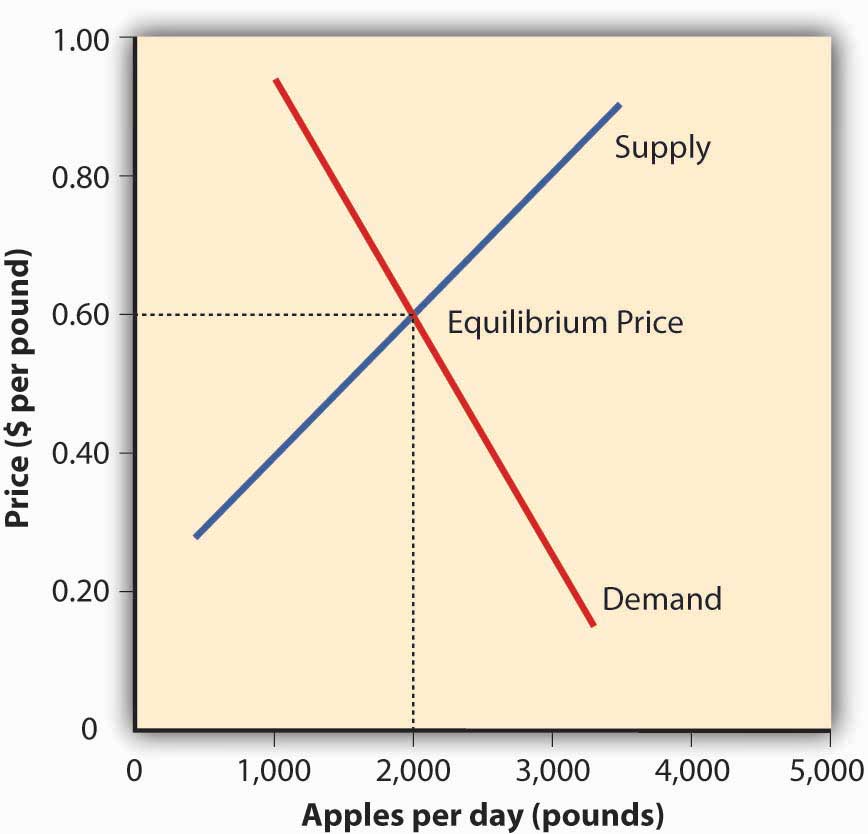All the sellers manage to sell the entire quantity of the commodity, which they offer for sale in the market at the equilibrium price. Buyers are also able to satisfy their demand wholly at the equilibrium price. In other words, here, there is neither unsold stock of the commodity nor any unsatisfied demand in the market due to inadequate supply.
Thus, at the equilibrium price, wishes of both the buyers and sellers are satisfied and the market will be in a state of rest. At all other prices, the wishes of buyers and sellers would be inconsistent and are, thus, disequilibrium prices.
They will not persist. If price is greater than the equilibrium price, supply would exceed demand. Some sellers will be forced to dispose of their unsold produce by bidding price down. The price will go on declining till the demand equals supply.
ADVERTISEMENTS:
Similarly, when market price is lower than equilibrium price, demand exceeds supply. Some unsatisfied buyers will, therefore, bid up price in their effort to get all that they desired to buy. The price will go on rising till the demand and supply are again equal.
Therefore, at any price other than equilibrium one, market forces will tend to cause changes in price-quantity towards equilibrium. We now explain the process of price determination with the help of a table given as follows.
Table 11.1 gives the demand and supply schedules of bathroom tiles sold by Amit Arora. It shows that as the price falls, the demand for tiles increases and the supply falls. Demand and supply are like two forces pulling in opposite directions and at the prices of Rs. 15, they are equal. Thus, the equilibrium price is Rs. 15 and equilibrium quantity at this price is 150.
ADVERTISEMENTS:
Table 11.1: Equilibrium Price Bathroom Tiles
The equilibrium between demand and supply can also be explained in graphical terms. In Fig 11.1, DD is the demand curve sloping downward and SS is the supply curve sloping upward. Market is in equilibrium at point ‘E’, where two curves intersect each other. At the equilibrium point, OQ quantity is demanded and supplied at price OP.
ADVERTISEMENTS:
In other words, at this point, the amount of the commodity that the producers are willing and able to supply to the market is just equal to the amount that buyers are willing and able to buy. Given the usual shapes of demand and supply, there will be only one point at which demand and supply will intersect. Hence, there will be one equilibrium price at which the demand (by the buyers) is equal to the supply (by the producers).
If the equilibrium is now disturbed and the price rises to OP1, the quantity of the good supplied is OQ2 will exceed the quantity demanded OQ1. Sellers will be willing and able to supply more of the good at this price than buyers are prepared to buy.
There is an excess supply equal to Q1Q2. In order to dispose of this excess supply, the sellers will compete with each other and in doing so the price will fall down facilitating way to clear unwanted in inventories.
Thus, there is a tendency of sellers to cut prices in the event of excess supply, implying a downward pressure on prices. Further, consumers noticing excess supply offer a lower price for the good. As price falls in this way, the quantity demanded will rise and the quantity supplied will fall. Ultimately, the demand and supply will coincide at the equilibrium price OP.
Conversely, if the price falls to OP2, the quantity demanded OQ2 will exceed the quantity supplied OQ1. The reason is that new consumers who could not afford this commodity at the higher price will also purchase it. Further, suppliers would restrict supply due to lower price. The excess demand in this situation is equal to Q1Q2.
More demand and less supply and competition between buyers as a result will force the price up, until excess demand is completely wiped out. The tendency of the buyers to bid up prices when there is excess demand implies an upward pressure on prices. Once again the equilibrium price of OP is reached. The corresponding quantity demanded and supplied will, thus, be OQ.
From the above, it follows that if the price is above or below the equilibrium price, certain forces in the system will operate to bring the price to the level of equilibrium price. It is also known as the stable equilibrium.
In the words of Marshall, “When demand and supply are in stable equilibrium, if any accident should move the scale of production from its equilibrium position, there will be instantly brought into place forces tending to push it back to that position, just as, if a stone hanging by a string is displaced from its equilibrium position, the force of gravity will at once tend to bring it back to its equilibrium position”.
At this stage, one question arises that between demand and supply, which is more important force in determining equilibrium price. Marshall likened demand and supply to the two blades of a pair of scissors moving in opposite directions.
Just as both the blades are needed to cut a piece of paper or cloth, both demand and supply together determine the equilibrium price through their interaction. However, supply is more important in the long period, as it cannot be adjusted according to the requirements in the short period.



